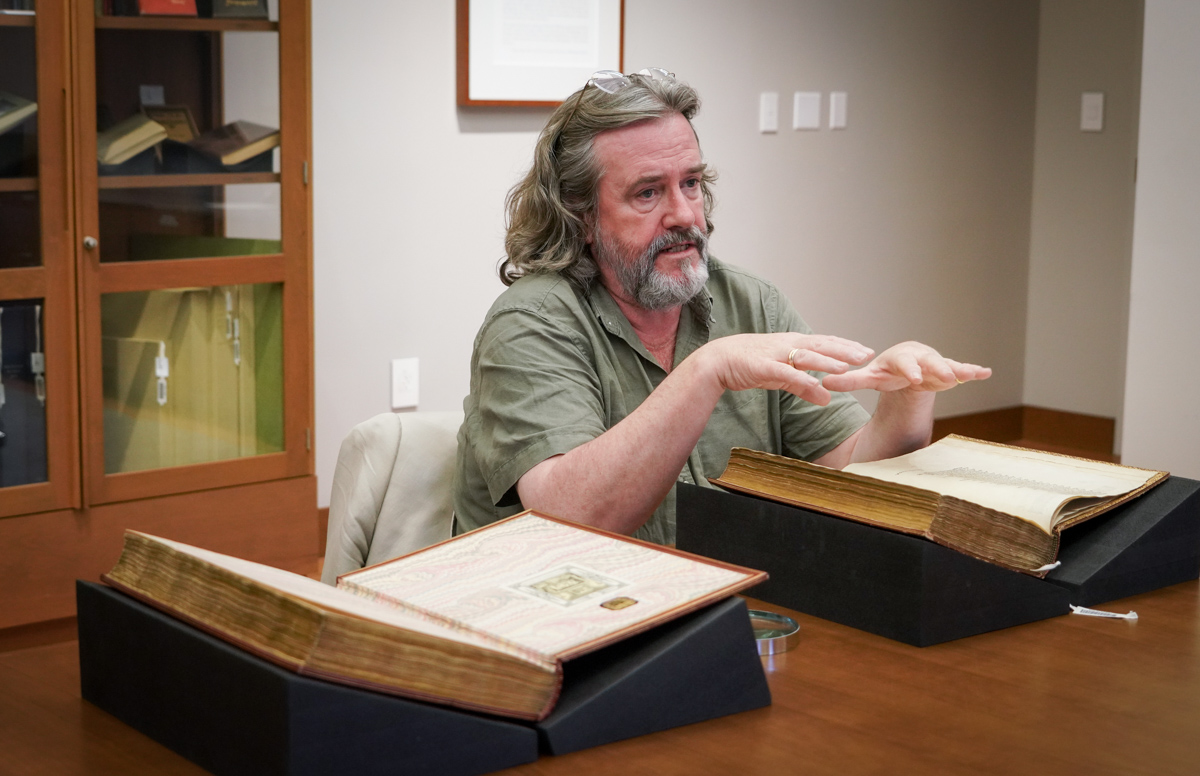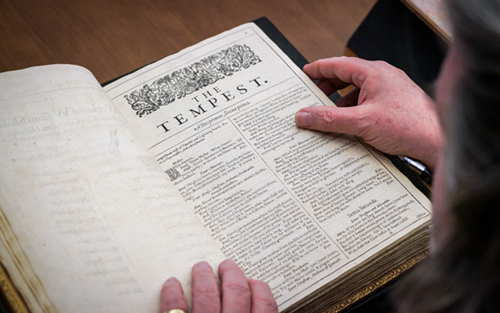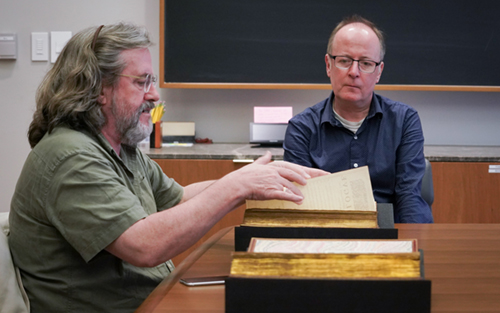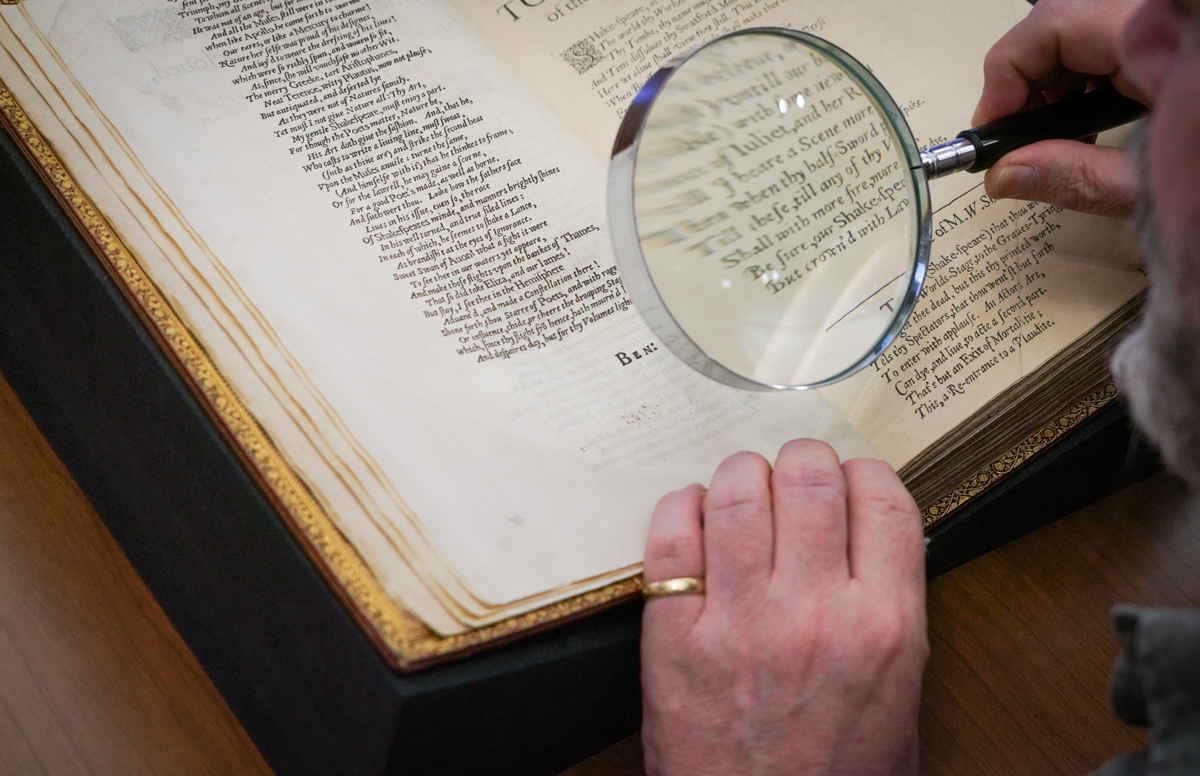
Can you imagine the Western literary canon without Macbeth or Julius Caesar? Or never hearing the immortal lines “All the world’s a stage. And all the men and women merely players.”?
We might not have those legendary works or words if not for Shakespeare’s First Folio, the earliest printed edition of the Bard’s collected plays, published in 1623. Without the folio, half of Shakespeare’s dramatic work — and its extraordinary influence on Western literature and culture — might have been lost to time.
Gregory Doran, the artistic director emeritus of the Royal Shakespeare Company (RSC), visited The Bancroft Library last week to see an original edition of the First Folio. He came to learn more about the volume for a podcast he’s producing that will mark the folio’s 400th anniversary in 2023.
For Doran, who has been hailed as “one of the great Shakespearians of his generation,” copies of the folio have much to reveal about history, theater, and the human experience.
“There are such human stories that kind of collect around the volumes that I just find very moving,” he said. “I’d been invited to a couple of places to see them anyway, and I thought … I’m going to make this a pilgrimage. I’m going to go and see these folios, and try to tell their stories.”
That journey has taken him across the United Kingdom, and to parts of the United States and Germany, where he has seen 47 volumes (and counting). Doran, who spent 35 years with the RSC before retiring this past April, spoke excitedly about the tales he’s gathered, including one famed folio copy read by King Charles I as he awaited execution.
At Bancroft, Doran interviewed David Faulds, curator of rare books and literary manuscripts, for the podcast project. Faulds was delighted to speak more about the library’s copy.
“As far as English literature is concerned, (the folio) is Bancroft’s greatest treasure,” Faulds said.


Top to bottom: Left to right: The Tempest is one of the plays in the First Folio; David Faulds, curator of rare books and literary manuscripts for The Bancroft Library, at right, and Doran chat about the folios and their origins.
Unique story
Bancroft’s folio first emerges in the historical record in the late-19th century as a possession of Rev. Reginald Cholmondeley of Condover Hall in Shropshire, England. Its story is recounted by scholars Eric Rasmussen and Anthony James West in their book, The Shakespeare First Folios, A Descriptive Catalogue.
The authors describe Cholmondeley as an eccentric naturalist and collector, who was friends with literary figures such as Mark Twain. After Cholmondeley’s death, the folio was auctioned in 1897 and purchased by a bookseller who bought the book “half bound, in bad condition, sold with all faults, for an undisclosed sum.”
The book arrived in California in 1899 after being purchased by Ethel Willard Crocker, the wife of the president of Crocker National Bank. Many First Folio volumes in the United States were acquired by industrialists or other wealthy families, possibly as symbols of status or cultural refinement, according to Doran.
Ethel Willard Crocker was well-known in the Bay Area as a philanthropist and patron of the arts. After the 1906 earthquake, she set up relief centers for the injured and displaced that came to be known as “Crocker camps.” The Crocker family, who also lost their home in the earthquake, gifted the Episcopal Church their land, which became the site of San Francisco’s Grace Cathedral.
“There are stories of philanthropy around this book,” Doran said, “but there are also great stories of, what I … think of as being very Shakespearean, which is a sense of humanity and compassion.”
The Crocker family donated the book to UC Berkeley in 1955, a gift that Faulds said speaks to the critical role that donors play in supporting The Bancroft Library.
“We could have never afforded the folio otherwise,” he said, noting that pristine copies can sell for several millions dollars. Although not a pristine copy — 26 facsimile pages were inserted in the 19th century — Bancroft’s volume is nonetheless irreplaceable, Faulds said.
Doran added that these particular pen-and-ink facsimile pages, hand-drawn by copyist John Harris and nearly indiscernible from the original leaves (so good, in fact, that Harris had to sign the pages so as not to be accused of forgery), are an element that differentiates the volume from others.

Power in preservation
Preserving the artistic legacy of their friend and fellow actor is exactly what John Heminges and Henry Condell had in mind when they compiled the First Folio seven years after Shakespeare’s death.
The work’s introduction even includes an elegiac poem by playwright Ben Jonson, a contemporary (and sometime rival) of Shakespeare, that features these illustrative lines:
… Thou art a monument without a tomb,
And art alive still while thy book doth live
And we have wits to read and praise to give. …
The book’s frontispiece is a portrait of Shakespeare that has come to define the literary luminary, and that would be recognizable to most American high school and college students from their English textbooks. That portrait is credited to the artist Martin Droeshout.
The First Folio includes 36 plays organized by theme: comedies, tragedies, and histories. Of those plays, 18 had never been published before the folio’s release, including the aforementioned Macbeth and Julius Caesar, as well as The Tempest and As You Like It.
Five of the plays will be performed by the Royal Shakespeare Company as part of its 2023 season — with Doran directing his 50th production — as a tribute to the folio’s lasting value.
Faulds said the folio retains an almost magnetic power, even after four centuries. He recounted a time that two students nearing graduation asked to see the book. “They were so excited, they were almost in tears,” he said. “Maybe particularly for this generation of students, who grew up with tablets and screens, to actually see the physical object is really significant.”
For Kate Donovan, director of The Bancroft Library, the legacy of the First Folio — and all of the diverse items in the library’s special collections — expands by being accessible to as many people as possible.
“It’s our ethical obligation to make sure that the treasures that Bancroft holds are equally available to everyone,” she said. “All are welcome here — the world famous scholar and the person who lives around the corner. That’s a core part of our mission.”